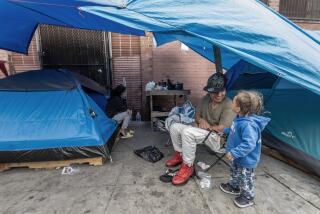Asthma Takes Toll on Homeless Kids
NEW YORK — When her young son Justin began coughing and wheezing Wednesday, Maria Garcia -- who lives in a homeless shelter -- hurried to the South Bronx Health Center for Children & Families. The physicians there confirmed what she already knew: His asthma had flared up again.
Justin, 3, was diagnosed with the disease when he was 6 months old. That was after he stopped breathing and was rushed to a hospital, where doctors used CPR to revive him.
This time, after adjusting Justin’s medications, the doctors sent him right home.
“It can be life-threatening,” Garcia said of her son’s attacks. “If you don’t run at the right time to the emergency room, the child can stop breathing. I really believe he has become more stable because he has been seeing the same doctor for a period of time.”
At the Prospect Interfaith Family Inn, where Garcia has been a resident for “a good three years,” the coughing of other children often keeps her up.
“You see a lot of ambulances get called to the facility for trips to the emergency room,” she said.
Almost 40% of the children in New York City’s homeless shelters suffer from moderate to severe asthma, which in many cases goes untreated, a recently released survey found. That’s more than six times the rate for children nationwide.
Researchers based their findings on 740 children examined when their families entered three shelters here. They stressed that their estimate was conservative, and the number of asthmatic youngsters may be well over 50%.
“What we have is some of the most medically underserved children in the country,” said Dr. Irwin Redlener, president of the Children’s Health Fund, an advocacy group that participated in the study, conducted in some of New York’s poorest neighborhoods. “The politics of asthma is the politics of poverty.”
“It is not good and it is getting worse,” said Diane E. McLean, a psychiatrist on the staff of the Columbia University/New York State Psychiatric Institute, who was the study’s lead author. “In New York City, homelessness is growing.”
When the researchers began their work in 1998, there were 9,400 children in the family shelter system. The number has grown to more than 16,000.
In New York City, according to the survey published in the March issue of the Archives of Pediatrics & Adolescent Medicine, asthma is the leading cause of hospitalizations for children from birth to 14 years of age.
Physicians have found asthma can be triggered by a pie chart of problems that are worse in impoverished areas: rodents, roaches, car and truck fumes, batteries left on the streets to rot, dust from buildings being demolished.
“We see a lot of asthma on a daily basis,” said Dr. Sharon P. Joseph, who cares for patients in a mobile medical van outside of homeless shelters. “Anxiety can exacerbate asthma. For a small child, homelessness has got to be a horror show.”
On Wednesday, the big blue van was parked outside the Lydia E. Hoffman Family Residence, not far from the clinic where Garcia’s son was treated. Joseph said that some days she sees nine or so children with asthma-related problems.
The disease affects more than 17 million Americans, almost 5 million of them children. The tragedy for many poor youngsters, doctors stress, is that the disease is highly treatable and controllable, but continuity of care is vital.
Garcia can testify to that fact. Before going to the South Bronx Health Center, which is operated by Montefiore Medical Center and the Children’s Health Fund, she shuttled from clinic to clinic, depending on where she lived. Often, physicians did not have proper records for her son.
“Since he has been seeing the same doctor for almost three years, the asthma has been regulated,” Garcia said, praising the physician who cares for Justin.
The quality of care is such, the 43-year-old mother said, that the doctor even makes house calls and has given her his cellphone number.
“I can reach him at any time,” Garcia said.
Joseph, 42, grew up in the South Bronx and has been a pediatrician in the area since 1991.
“I saw patients who were nine and are now 21,” she said. “I think the best thing is talking to patients and asking them, ‘What do you want to do? What do you want to be?’ You see they want to be doctors. They want to be lawyers. You see ones that look to you as a role model -- someone who looks like them who wants to do things that maybe they didn’t think they could do.”
She said her patients find the van with its two examining rooms, television and books to be a friendly place.
“They want to live in the van,” the pediatrician said. “When they come in, they want to stay.”






